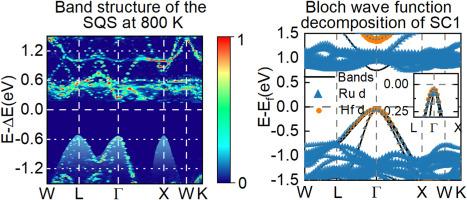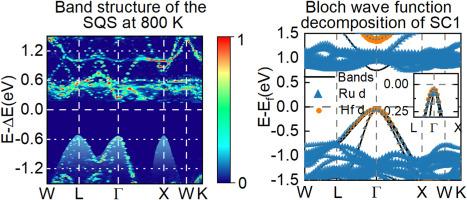HfRu1.5Sb中空位有序-无序跃迁和能带收敛的第一性原理研究
IF 9.7
2区 材料科学
Q1 MATERIALS SCIENCE, MULTIDISCIPLINARY
引用次数: 0
摘要
报道了半heusler -like HfRu1.5Sb中空位驱动的短程序的发现,以及其对电子结构的量化影响。通过对密度泛函总能与团簇展开积分和大胞Monte-Carlo退火模拟,发现在1100K发生有序-无序相变,与实验结果1170K一致。在室温下,通过四维子晶格上Ru空位的空间排列,确定了两种接近简并的基态构型GS1和GS2。虽然GS1和GS2的短程有序参数显示出相似的有序趋势,但特别是在GS2中,Ru空位形成了包裹Hf原子的四面体构型,从而削弱了相邻的Hf - Ru键相互作用。这些四面体基序引入了额外的价带谷,其权重随无序程度的变化而变化,增强了能带收敛效应。本研究系统地揭示了HfRu1+xSb中空位有序-无序转变的形成机理及其对电子结构的影响,为优化热电性能和设计先进的半heusler类材料提供了理论指导。本文章由计算机程序翻译,如有差异,请以英文原文为准。


Vacancy order–disorder transition and band convergence in HfRu1.5Sb: A first-principles study
The discovery of vacancy-driven short-range order in the half-Heusler-like HfRu1.5Sb is reported, along with its quantified impact on the electronic structure. By integrating density-functional total energies with cluster expansion and large-cell Monte-Carlo annealing simulation, it was found that the order-disorder phase transition occurred at 1100K, which is consistent with the experimental 1170K. And two nearly degenerate ground-state configurations (GS1 and GS2) are identified at room temperature, distinguished by the spatial arrangement of Ru vacancies on the 4d sub-lattice. Although short-range order parameters reveal similar ordering tendencies in both GS1 and GS2, it is specifically in GS2 that Ru vacancies form tetrahedral configurations encapsulating Hf atoms, thereby weakening adjacent Hf–Ru bonding interaction. These tetrahedral motifs introduce additional valence band valleys, whose weight scales with the degree of disordering, enhancing the band convergence effects. This study systematically reveals the formation mechanism of the order-disorder transition of vacancies in HfRu1+xSb and its effect on the electronic structure, providing theoretical guidance for optimizing thermoelectric performance and designing advanced half-Heusler-like materials.
求助全文
通过发布文献求助,成功后即可免费获取论文全文。
去求助
来源期刊

Materials Today Physics
Materials Science-General Materials Science
CiteScore
14.00
自引率
7.80%
发文量
284
审稿时长
15 days
期刊介绍:
Materials Today Physics is a multi-disciplinary journal focused on the physics of materials, encompassing both the physical properties and materials synthesis. Operating at the interface of physics and materials science, this journal covers one of the largest and most dynamic fields within physical science. The forefront research in materials physics is driving advancements in new materials, uncovering new physics, and fostering novel applications at an unprecedented pace.
 求助内容:
求助内容: 应助结果提醒方式:
应助结果提醒方式:


